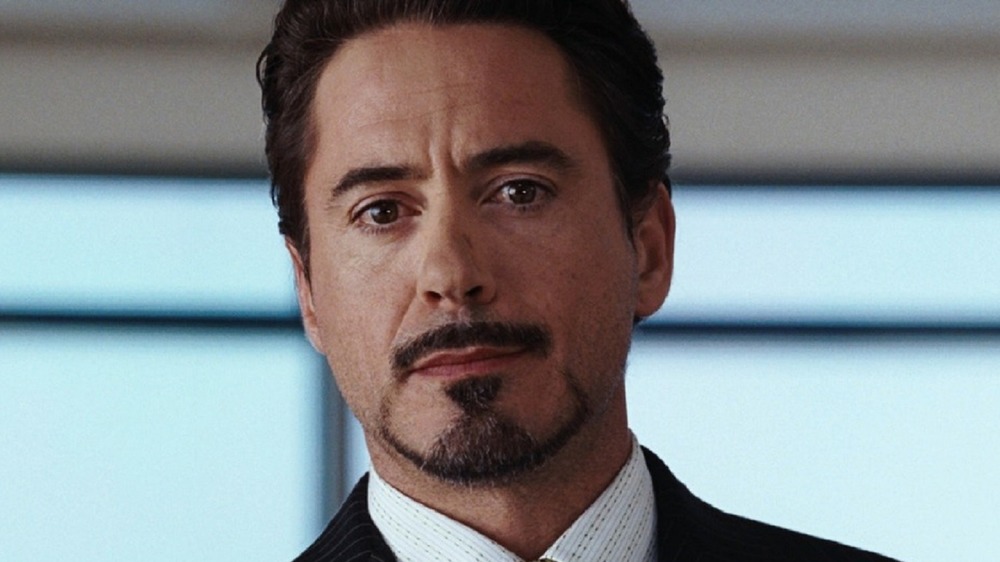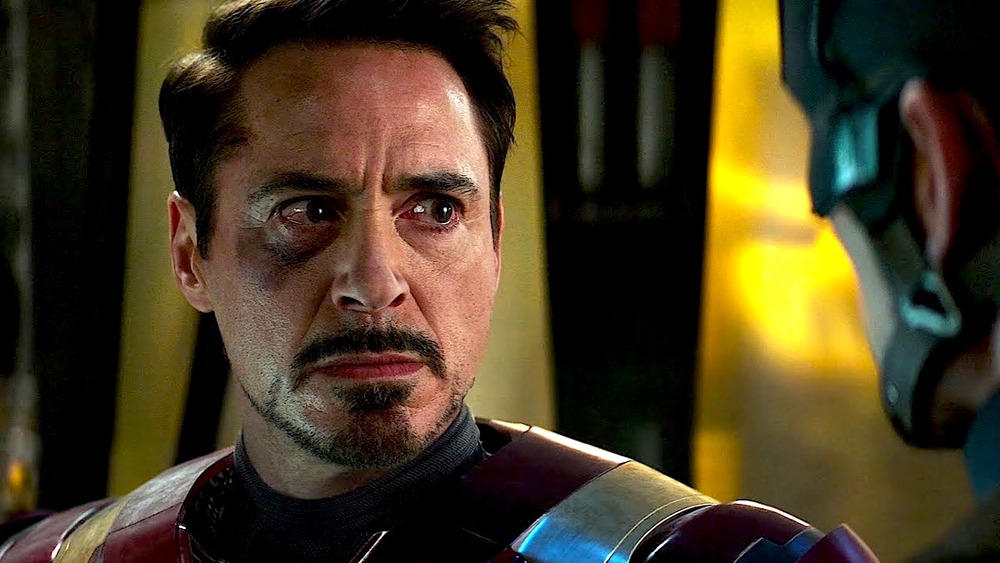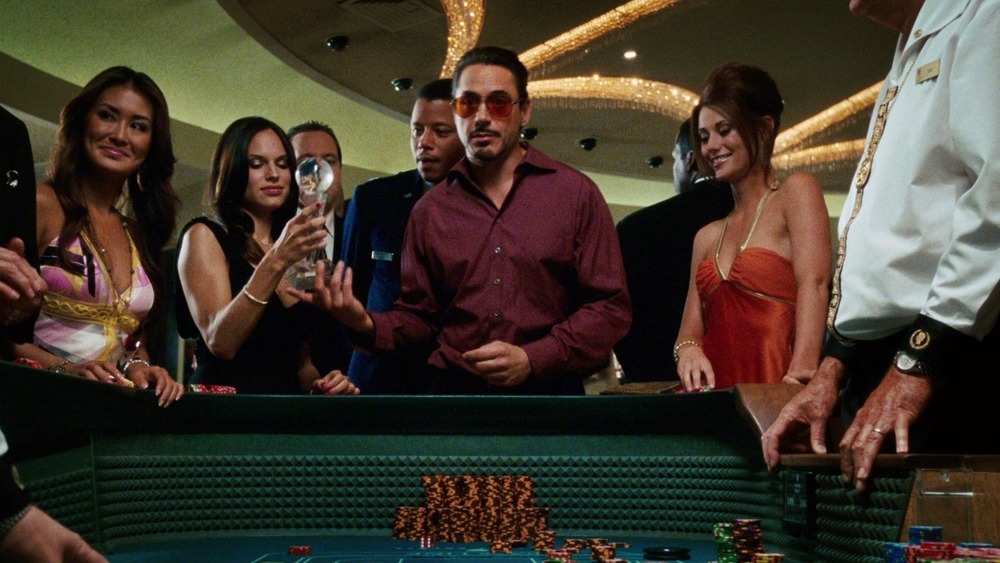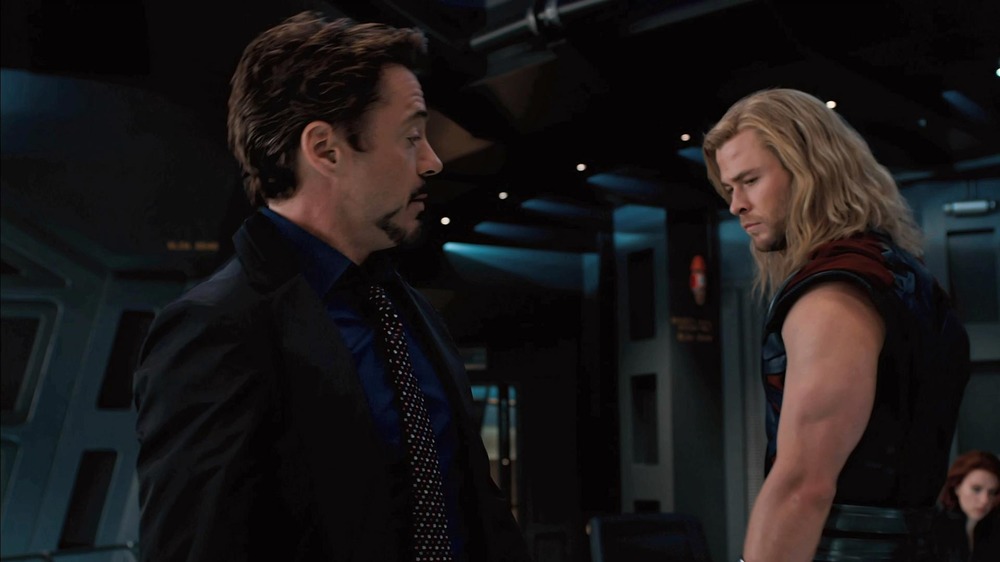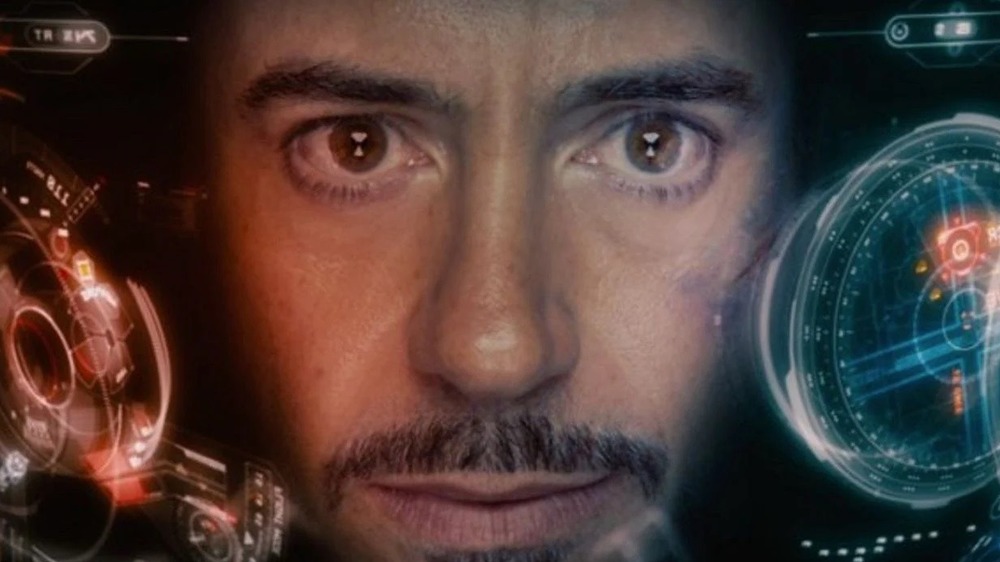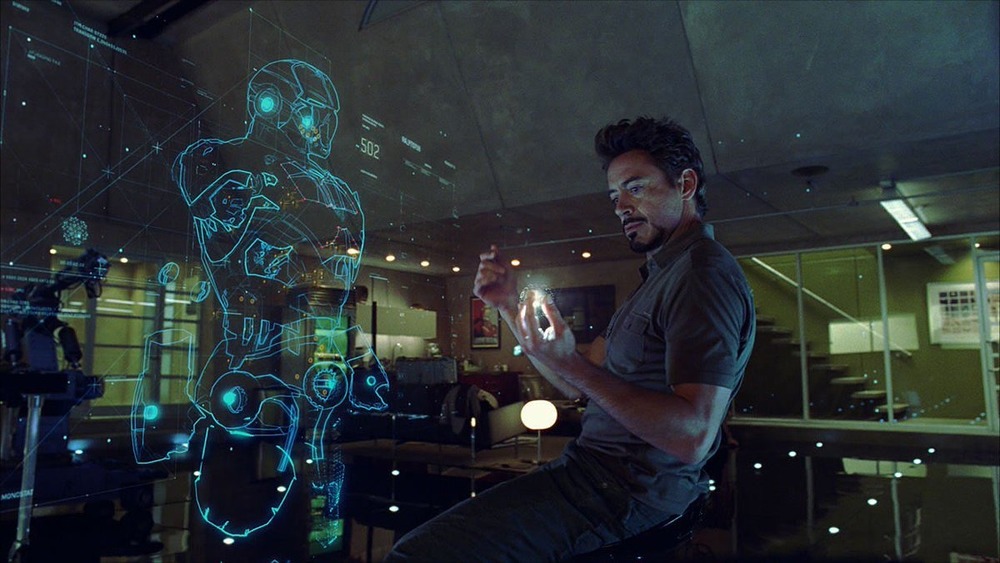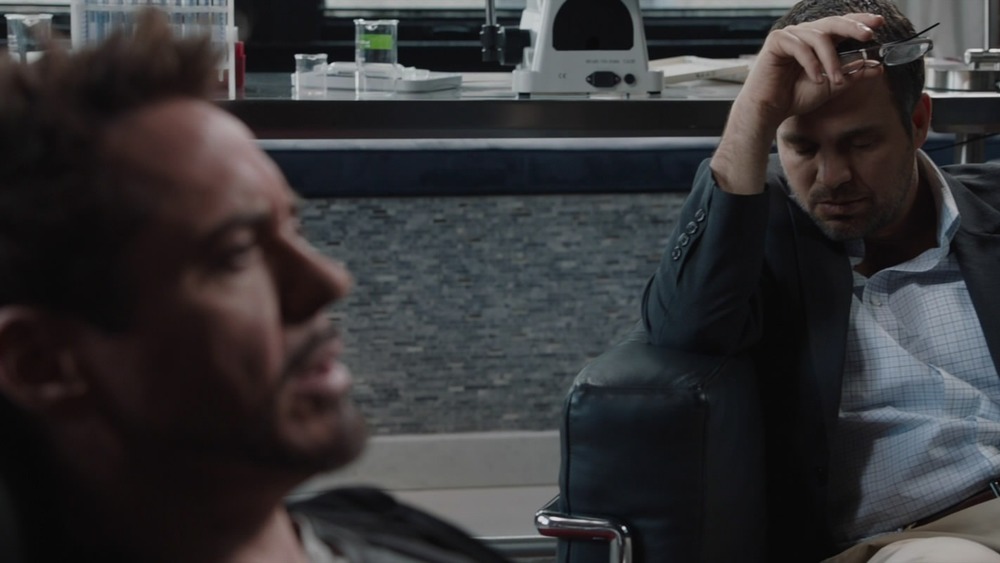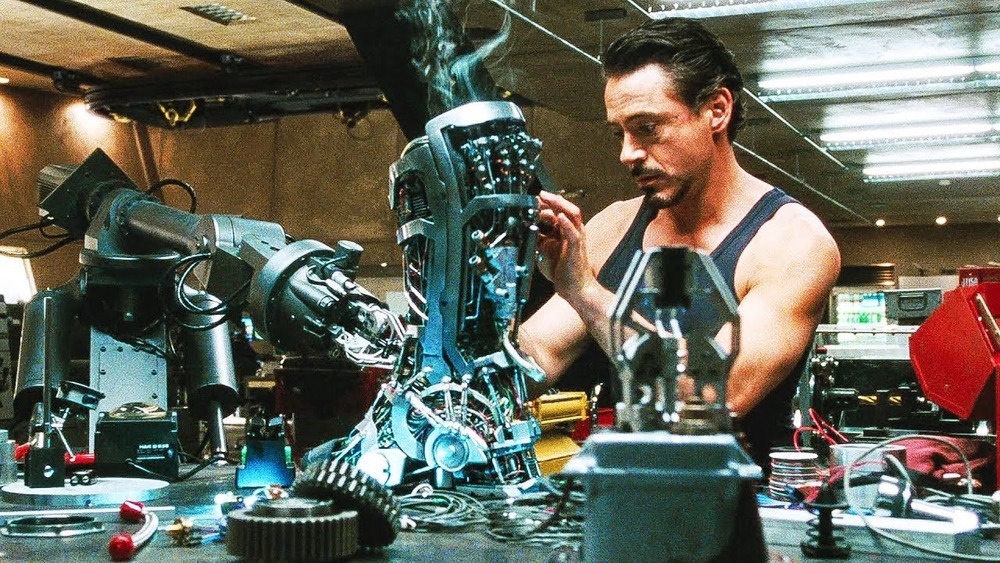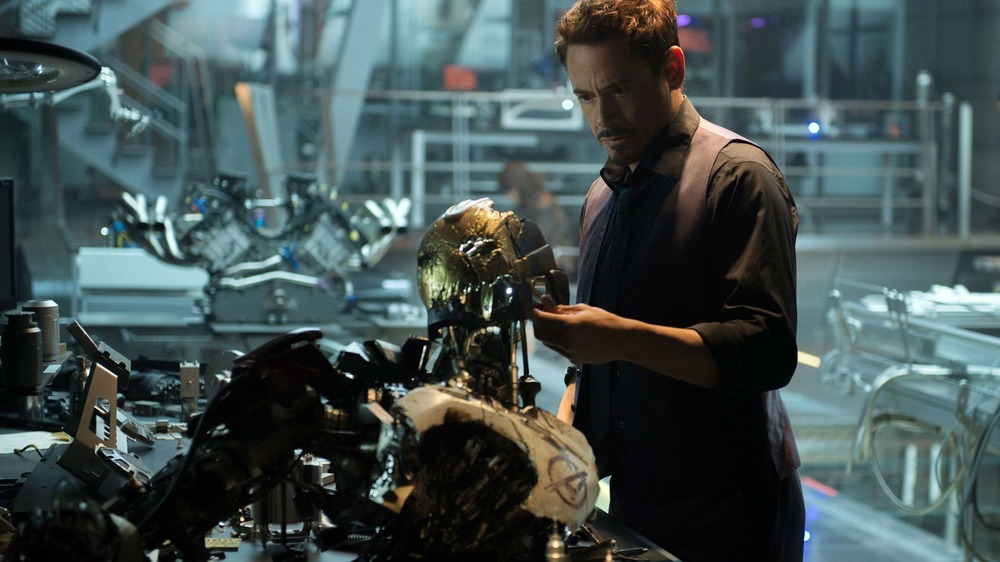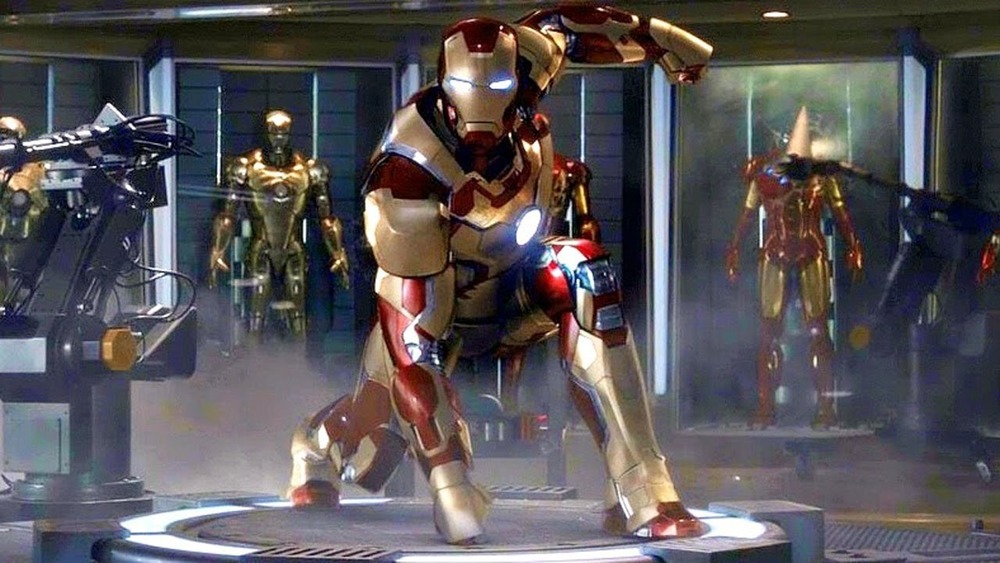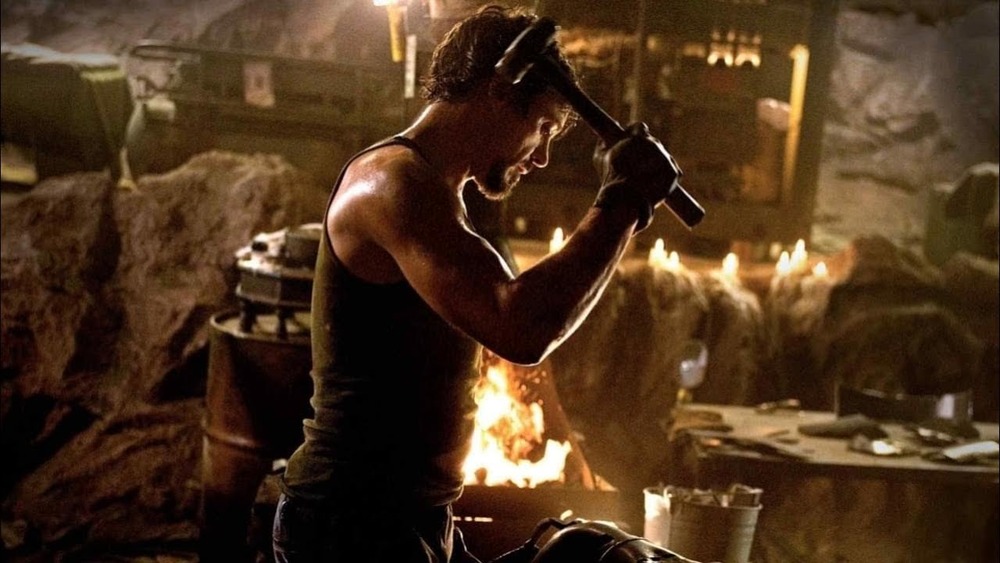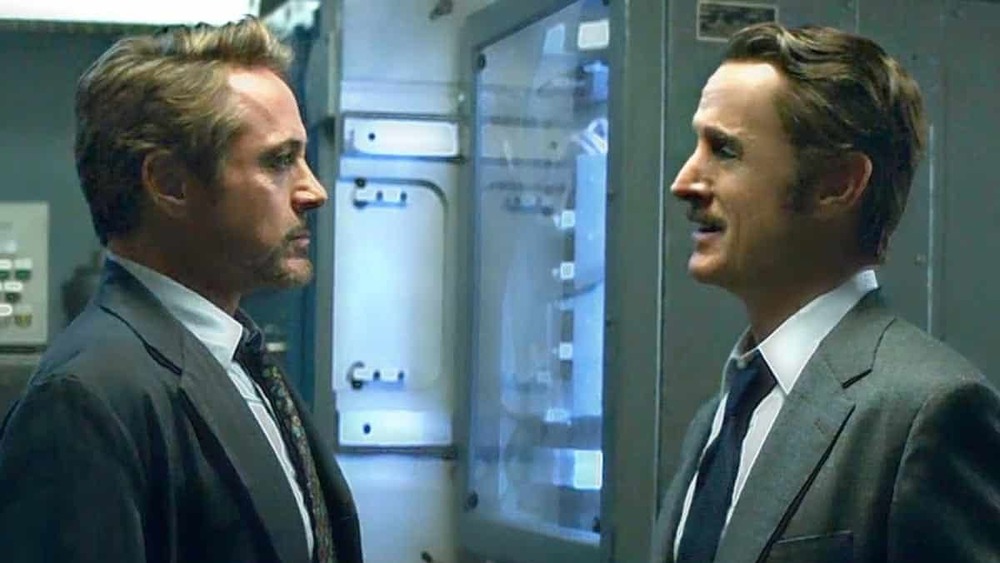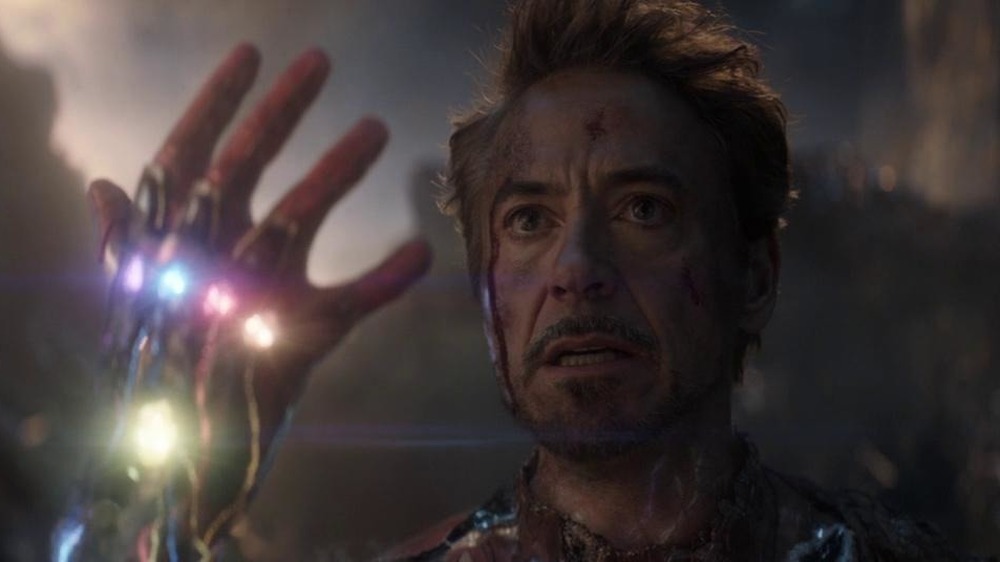Rules Iron Man Has To Follow In The MCU
There are certain things we come to expect from any character in a long-running franchise, and there's no better example of that than the Marvel Cinematic Universe. After more than a decade with some of Marvel's iconic characters, we know that we can always expect Thor to summon lightning or Captain America to throw his shield every time they appear in a new film. While certain expectations can eventually be subverted for the sake of plot and character development — such as other Avengers gradually proving themselves worthy of Thor's hammer — others have remained reliably consistent throughout the years. That's especially true when it comes to a certain genius, billionaire, playboy, philanthropist.
With Tony Stark's run in the MCU now having reached its conclusion (give or take a possible posthumous and/or alternate reality cameo somewhere down the line), we can clearly look back at his entire journey and see which things changed over time and which held steady from beginning to end. While both Tony and his superhero alter ego evolved greatly between Iron Man and Avengers: Endgame, here are some of the rules he always followed in the MCU.
Tony knows best
Ever since The Avengers in 2012, Tony has functioned as the de facto leader of the group, which no one ever seems to question until he goes toe to toe with Steve Rogers in Captain America: Civil War. Yet Tony probably doesn't take the prize for the most heroic or selfless member of the crew, so why does he get to be in charge of a group of superheroes? In addition to partially bankrolling the team (especially after the disintegration of S.H.I.E.L.D.), a big part of why Tony's the boss seems to boil down to one simple fact — he's convinced he knows best.
Whether he's arguing with Steve about the right way to handle Loki or arguing with Steve about whether to sign the Sokovia Accords (he argues with Steve a lot), Tony always thinks he's right, and he isn't willing to consider opposing viewpoints. Even in Infinity War and Endgame, when Doctor Strange has seen into the future and knows the outcome, Tony obviously struggles with the idea that someone might have a better idea of what's going on than he does. And in his solo films, despite near-constant pushback from his closest friends, he nearly always plows ahead with his plans, convinced that because he's the smartest person in the room, he can never be wrong.
Iron Man constantly reminds everyone that he's rich
If the towering New York skyscraper and the Malibu mansion weren't enough to communicate that Tony Stark is one of the richest people on the planet, Tony himself is always more than happy to remind those around him of his vast wealth. Whether he's casually shrugging off a 40% stock dip in Iron Man, reminding Steve Rogers he's a billionaire in The Avengers, or mentioning that he bought Pepper a Harry Winston engagement ring in Infinity War, Tony likes to casually drop references to his money into conversations.
Granted, as far as billionaires go, you could do a lot worse than Tony Stark, who also uses his money to fund the Avengers, paying for both the tower in New York City and the compound in Upstate New York. Tony also dips into his own pockets to pay for all sorts of advanced tech that he intends to use to protect humanity. But perhaps more importantly than that, he funds the Stark Relief Foundation, which provides aid to civilians who were harmed during the course of the Avengers' world-changing battles, and the September Foundation, which provides funding for schools and promising students in tech fields. So even though he's indisputably lavish in his lifestyle and a little insufferable in how he flaunts his wealth, at least he's using it for some good things, too.
He never misses an opportunity to dole out ridiculous nicknames
Even with the fate of the world hanging in the balance, Tony Stark can't help but dish out pop culture nicknames to pretty much everyone he meets. In Infinity War, when he's faced with the villainous Ebony Maw of the Black Order, he can't resist dubbing him "Squidward." Other nicknames he's bestowed upon his fellow heroes include "Legolas" for Hawkeye in The Avengers, "Underoos" for Spider-Man in Captain America: Civil War, and of course, "Point Break" for Thor in multiple movies, which he also programmed into the Quinjet as the only name for the Norse god that the computer would recognize.
You'd think that inhabiting a universe where his friends are already named things like "Black Widow" and "Captain America," he wouldn't feel the need to come up with new, ridiculous-sounding names, but Tony is rarely ever satisfied by anyone's actual codenames or given names (even when those titles are a little outside the box themselves, such as "Happy" or "Pepper"). Then again, maybe it's precisely because Tony is surrounded by people with odd and silly names that he finds it necessary to up the ante — or, maybe he's just never bothered to learn anyone's name, and this is how he gets around anyone noticing.
Computers are his friends
Possibly because he's always convinced he knows better than everyone else, Tony Stark has a hard time making friends. Sure, he's always surrounded by fawning admirers, but he has very few real relationships in his life. Even two of the people closest to him, Happy Hogan and Pepper Potts, were both also on his payroll. This isn't to suggest at all that they were just close to Tony to collect a paycheck but rather to point out that they were financially tethered to him for long enough that they were able to wear down his defenses and establish an unlikely bond. The only other characters who ever managed to get under his emotional guard were James Rhodes, Peter Parker, and of course, Tony's daughter Morgan, who loved him 3000.
Yet as hard as it was for Tony to form human relationships, he always had a much easier time with machines, and he created AIs to interact with and rely on. His first AI companion was JARVIS, until that program was repurposed into Vision. Rather than go without an artificial assistant, Tony immediately programmed FRIDAY to take JARVIS' place. He relied on his AI assistants not only to help him control his suits and pull the strings of his high-tech home but also as a sounding board for his ideas ... and even sometimes as emotional support. Tony programmed JARVIS and FRIDAY to know him inside and out and to provide whatever he needed at any given time. As a result, they felt like more than programs, and eventually, they felt like friends.
Iron Man's mind is stronger than his suit
From his very first Mark I armor that he crafts secretly while held captive by the Ten Rings in Iron Man to the nanotech Mark LXXXV suit that he wears in Avengers: Endgame, Tony Stark is constantly coming up with mechanical ways to make himself stronger, faster, more resilient, and ultimately, more effective as a superhero. But while Iron Man the hero seems inextricable from the suit, Tony's actual greatest asset isn't his armor but his mind.
Tony is constantly thinking his way out of problems, using his suits as tools in his plans rather than the plans themselves. Case in point, the Mark I was created out of necessity, using the parts he was given to build weapons for terrorists to instead create a way to escape his captivity. Nearly every time we see Tony appear in the MCU, there's a problem he has to solve that resists the suit as the solution, whether it's breaking into the Mandarin's compound in Iron Man 3 or coming up with a way to stabilize the quantum realm in Avengers: Endgame. As strong as the Iron Man suit is, it can never compare to the brilliant mind of Tony Stark, which is actually one of the Avengers' greatest assets.
Tony never goes to therapy ... even though he definitely should
While it's subtler for some heroes than others, it becomes clear over the many years of the MCU that superhero work doesn't come free of psychological scars. With Tony, however, he wears much of his trauma on his nanotech sleeves. At the start of the MCU, Tony's biggest issues seem to revolve around his self-centeredness and his inability to empathize with others, which alone would give a therapist a lot to work with. But after nearly dying at the end of The Avengers, Tony shows significant PTSD symptoms when we next see him in Iron Man 3 and Age of Ultron.
Yet rather than seek professional help, Tony tries to invent himself out of trauma, churning out tricked-out Iron Man suits and advocating for a shield around the entire world. Those closest to him gently suggest that perhaps this isn't the healthiest way to deal with his issues, and Tony seems to take the note ... sort of. At the end of Iron Man 3, we do indeed see him spilling his guts to a doctor, but it's a sleeping Bruce Banner, not a trained therapist. And then he decides to invent his own treatment again, coming up with a way to holographically interact with his own memories in Captain America: Civil War. We know that Tony always has to have all the answers and be the solution to every problem, but becoming his own therapist seems like too much of a stretch, even for him.
Iron Man can always see room for improvement
A superhero's work is never done, especially when that superhero is chronic perfectionist Tony Stark. While Tony is constantly convinced he's got the best solution to any given problem, he's simultaneously never convinced that said solution is as good as it could be. Everything can always be made a little better if he just keeps working on it, or at least, that's his prevailing philosophy.
Sometimes, this never-ending striving for improvement actually works against him, resulting in a number of quickly developed, undercooked projects that never quite reached completion, since Tony's actions couldn't keep up with the pace of his brain. We see this play out in Iron Man 3, when Tony invents suit after suit but never fully perfects any of them. Other times, though, this hankering for improvement works in his favor, such as when he figures out time travel in Endgame after initially refusing to work on it. Knowing he should walk away from something and actually doing that are two different things, and when Tony gets a feeling that something can be improved — which is always — he's simply incapable of letting it go.
He's always trying to prevent his last mistake
While Tony Stark is always convinced he's right about his current plan or stance, he's also curiously able to look back and admit when he's made a mistake. It's not a characteristic one might expect from someone with Tony's personality, but once you factor in Tony's constant problem-solving, it begins to make sense. After all, if Tony views his mistakes as a problem that must be fixed, it's no wonder that he tends to center on them so strongly.
We especially see this in Age of Ultron, when he becomes so preoccupied with the fact that the world was unprepared to face extraterrestrial threats in The Avengers that he inadvertently creates a supervillain in the name of protecting Earth. And even though his Ultron plan fails spectacularly, Tony is still focused on going back and fixing his mistake (allowing an outside threat to attack the planet) by the time Endgame rolls around. In fact, one of the first things he says after arriving back from space is that Steve should've let him build a suit of armor around the world to prevent Thanos from arriving.
Many of Tony's inventions and strategies are more about reacting to something that's already happened, in the hopes he can prevent it from happening again, than they are about looking forward. So, it's only fitting that in Endgame, he gets to actually travel to the past and finally undo what he views as his biggest mistake — failing to save the world.
Tony constantly upgrades his Iron Man armor
Iron Man may only appear in ten movies, but if you pay attention to how many versions of his armor he goes through, it becomes evident that he always invents numerous new suits in between films. The first real set of Iron Man armor (after the Mark I prototype, of course) looks pretty good and is undeniably effective, but it's also bulky and cumbersome, making it necessary for Tony to focus mostly on lasers and blunt, brute strength in his fights rather than speed and precision.
In later Iron Man films, we see Tony continually tweaking his armor, making it sleeker and more agile, and loading it up with increasingly impressive features. In Iron Man 3, he adds the game-changing functionality of being able to call his armor to him from a remote location and have it automatically latch onto his body. And by the time Infinity War rolls around, he's figured out how to make the entire suit out of nanotech stored in a glowing container on his chest, made to resemble his original arc reactor. The final Mark LXXXV suit conforms smoothly to his body, is tricked out with a staggering array of weapons, and automatically reforms when damaged. It seems like the ideal Iron Man suit, yet we're sure that if Tony had survived Endgame, he would've found a way to improve upon it yet again.
Building his suits builds his character
It's easy to think of the suit as Iron Man's defining feature, but really, the suits are more of an extension of Tony Stark himself. He built the first one out of desperation, when he knew he couldn't morally build the weapons that were being demanded of him and needed to escape. Through creating the Mark I, Tony discovered inner bravery that he never knew existed, and he also found himself bonding with his fellow captive, Ho Yinsen, letting down his guard to truly care about someone.
After that situation, building subsequent suits have not only helped Tony feel safe and useful and acted as a sort of therapy for him, they've also been markers on his journey toward becoming a better person. Each time Tony remakes his suit as a response to a new problem, he also takes some personal strides forward. The Tony who sacrifices himself for the good of the universe at the end of Endgame is one who's been tempered and galvanized by the difficulties he's faced as he's grown more confident, capable, and cooperative as Iron Man. Just as he's carefully crafted each of his suits himself throughout the MCU, always refining them to be just a little bit better than the last, he's also crafted himself into a better person, one who's willing to save the world, whatever it takes.
Iron Man has some major daddy issues
Although it doesn't really come to a head until Captain America: Civil War, when Tony is forced to reckon with the tragic circumstances of his parents' deaths, Tony's father issues are a constant theme throughout his time in the Marvel Cinematic Universe. In the first Iron Man film, we can see him yearning to distinguish himself as his own man as he pivots dramatically from the past direction of Howard Stark's company. Then in later films, especially in his interactions with young Peter Parker in Spider-Man: Homecoming and Harley Keener in Iron Man 3, it becomes evident that Tony has some complicated feelings around fatherhood and children, especially the idea of a son.
In Civil War, we see him admit to a roomful of tech students that he's never really processed his grief from losing his parents, which goes a long way toward explaining both his paternal leanings with the kids in his life and his constant striving for his deceased father's approval. In Endgame, he gets a chance to have a cathartic encounter with his dad through traveling back to the 1960s, offering him some much-needed closure for his unresolved issues with his father. Yet it's probably by becoming a dad himself that Tony finds the most healing, and by soothing those deep parental wounds through his relationship with Morgan, Tony is able to find the strength to make the ultimate sacrifice for her.
No problem is ever too big for Iron Man
From legions of alien monsters threatening to wipe out New York City to a seemingly invincible purple madman hellbent on destroying half the universe, Tony Stark never backs down from a fight. This may seem to be a quality shared by most superheroes, but even among the good guys of the MCU, Iron Man is a little exceptional in this regard. After all, even if he finds himself without his suit, as happens in Iron Man 3, he always keeps working the problem until he comes up with a solution.
The only time we ever see Tony seemingly at a loss is at the end of Infinity War and the beginning of Endgame, not because he's given up but because someone else has. After he's been impaled through the chest by Thanos, Tony is determined not to surrender, so he can't fathom that Doctor Strange does. Five years later, as much as Tony claims he's content, he can't resist the urge to jump back in and tackle the problem that got away from him — and this time he solves it. We shouldn't be surprised. After all, this is the same Tony Stark who didn't back down in the face of terrorists, supervillains, broken tech, aliens, or a heart full of shrapnel. What's a little time travel to a guy like that?
